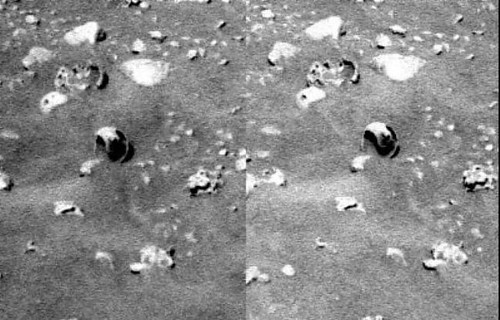New Mars Forums
You are not logged in.
- Topics: Active | Unanswered
Announcement
#126 2012-09-23 05:48:19
- Vincent
- Banned
- From: North Carolina USA
- Registered: 2008-04-13
- Posts: 623
Re: Official MSL / Curiosity Rover Thread | Aug 5, 2012 10:31 p.m. PT
I used the term constant in my last post. To support this I have included a nighttime infrared(IR) image. White is cold and dark is warmer. At the top of Mt Sharp it is very dark. The constant winds there, even at night, helps keep temperatures constant. In the lower elevations the wind is calm and we get radiational cooling. The small differences in the lowlands depict the different thermal inertia of the different surface materials.
Looks like WNW at night.
Vincent
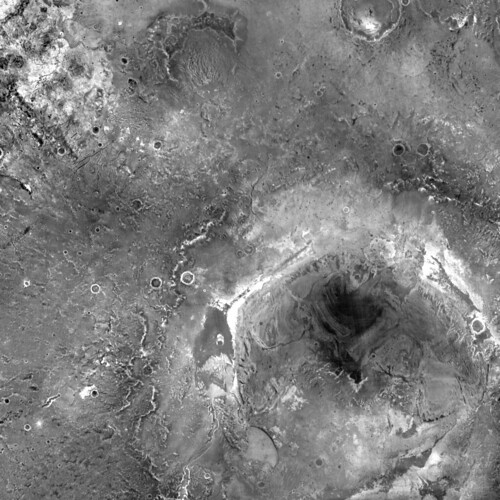
ir night gale by dfrank39, on Flickr
Last edited by Vincent (2012-09-23 05:54:49)
Argument expected.
I don't require agreement when presenting new ideas.
-Dana Johnson
Offline
Like button can go here
#127 2012-09-23 11:20:48
#128 2012-09-23 11:28:24
- SpaceNut
- Administrator
- From: New Hampshire
- Registered: 2004-07-22
- Posts: 29,599
Re: Official MSL / Curiosity Rover Thread | Aug 5, 2012 10:31 p.m. PT
Thank you Vincent as the images that you have posted do tell many thousands of words about Mars past and current conditions....
Offline
Like button can go here
#129 2012-09-24 11:33:03
- Vincent
- Banned
- From: North Carolina USA
- Registered: 2008-04-13
- Posts: 623
Re: Official MSL / Curiosity Rover Thread | Aug 5, 2012 10:31 p.m. PT
We did indeed live long enough to get the morning observation from sol 44. The sun appears to be rising in the NE. I must of lost my Bering. After further review the prevailing wind in the crater is more north-northwest.
This image was cropped and enlarged. The only alteration was removal of the vinette and mid tone brightening as to not disturb real contrast. This should be as close to reality as the computer algorithms can produce.
There is a restriction of visibility. The first choice is dust. It would be hard to think of Mars with no dust so we must assume it is there. The question is, to what degree? Daytime observations suggest only slight restriction of visibilities. I will assume dust constitutes less than 20%. The second restrictor is "ice haze." This is sometimes referred to as "ice fog." I am not privy to the criteria or rationale for this distinction. It was reported during decent in the afternoon with a "low lying" specifier. Either way visibilities are above three miles.
Gale crater is on the boundary of the northern lowlands a southern highlands. I will submit another post shortly about weather on this boundary.
Vincent

NLA_401372570EDR_F0042002NCAM00517M_stretch by dfrank39, on Flickr
Last edited by Vincent (2012-09-24 12:24:17)
Argument expected.
I don't require agreement when presenting new ideas.
-Dana Johnson
Offline
Like button can go here
#130 2012-09-24 12:14:36
- Vincent
- Banned
- From: North Carolina USA
- Registered: 2008-04-13
- Posts: 623
Re: Official MSL / Curiosity Rover Thread | Aug 5, 2012 10:31 p.m. PT
This is a crop from ESA titled, "Equatorial CO2 clouds and fog." This was latter debunked by thermal profiles. IT is H2O fog and supported as such by NASA.
Image ref: http://www.esa.int/SPECIALS/Mars_Expres … DAF_1.html
As you can see fog and low clouds do form and encroach from the north. This looks like Gale Crater but was unable to verify with Google mars. As you know it is a long equator but the boundaries are the same. The differences are what we want to know.
Expect water "ice haze" and dust with a few high level clouds at times. Morning frost dependent on elevation and thermal inertia of surface materials. Mornings could get interesting over time.
Vincent
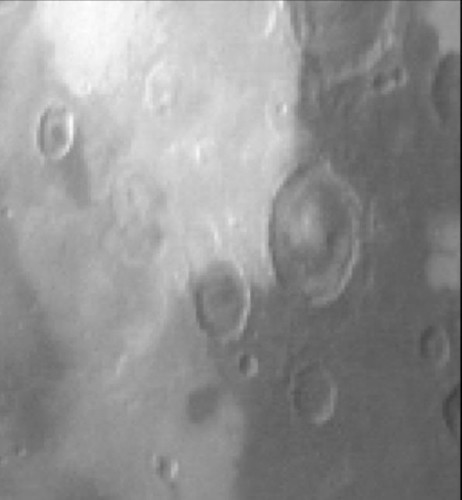
Cloud2_H2O 1 by dfrank39, on Flickr
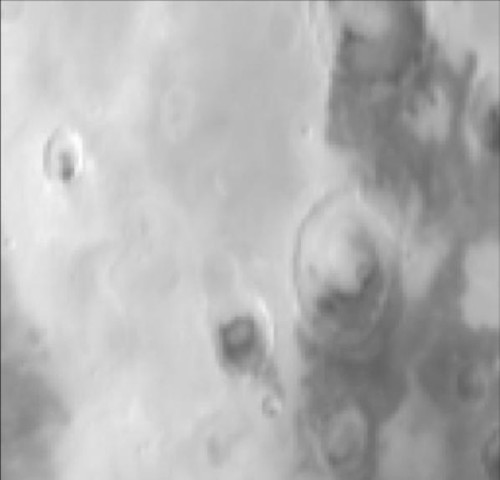
Cloud2_H2O 2 by dfrank39, on Flickr
Argument expected.
I don't require agreement when presenting new ideas.
-Dana Johnson
Offline
Like button can go here
#131 2012-09-24 12:58:17
- Vincent
- Banned
- From: North Carolina USA
- Registered: 2008-04-13
- Posts: 623
Re: Official MSL / Curiosity Rover Thread | Aug 5, 2012 10:31 p.m. PT
New all-time record high temperature of 6C or 43F. Sol 47.
Ref: http://marsweather.com/data
Vincent
Last edited by Vincent (2012-09-24 12:58:47)
Argument expected.
I don't require agreement when presenting new ideas.
-Dana Johnson
Offline
Like button can go here
#132 2012-09-24 16:33:07
#133 2012-09-26 02:07:54
- Vincent
- Banned
- From: North Carolina USA
- Registered: 2008-04-13
- Posts: 623
Re: Official MSL / Curiosity Rover Thread | Aug 5, 2012 10:31 p.m. PT
Our first MASTCAM "natural color" image of the Martian sky. It is green, as it should be. In right upper quad you will see Phobos passing by...
Vincent

0045MR0209002000E1_DXXX11111 by dfrank39, on Flickr
Last edited by Vincent (2012-09-26 02:21:37)
Argument expected.
I don't require agreement when presenting new ideas.
-Dana Johnson
Offline
Like button can go here
#134 2012-09-26 11:35:53
- Vincent
- Banned
- From: North Carolina USA
- Registered: 2008-04-13
- Posts: 623
Re: Official MSL / Curiosity Rover Thread | Aug 5, 2012 10:31 p.m. PT
This may be a good time as we drive to a more interesting area, to talk Mars Sky. The future stopping point, is in fact a triple point of different surface material. Some small buttes with layers should provide a valuable base line of data for future exploration.
Now some may think that I am a genius for predicting the sky would be green. This is not the case, LOL. First I was fortunate enough to study with "Hortonheardawho." He is one of the premier image guys on the net. I will post a link to him below. The only reason he is not the top guy is because, "he sees things." Things in the rocks and surface material. He is a free "thinker"
In my studies with him the Viking images were discussed. It seems when they first took images the blue band was reset to 800 nanometers (nm). This revealed a blue sky. The battle between the blue sky and red sky camps lasted for years. Funny, we were both wrong.
The raw data, without the genius input from anyone seems to be right. This is a raw data image from Viking. What we now call "natural color." The sky has a green hue and the violet layer is probably a dust layer trapped in inversion or Simi-permanent feature. It is real. It is a the best so far. It seems everything is beautiful in its own way. We just need to leave it alone.
Vincent
Image Ref: http://nssdc.gsfc.nasa.gov/photo_galler … -mars.html
Link to Hort, pack a lunch: http://www.flickr.com/photos/hortonheardawho/
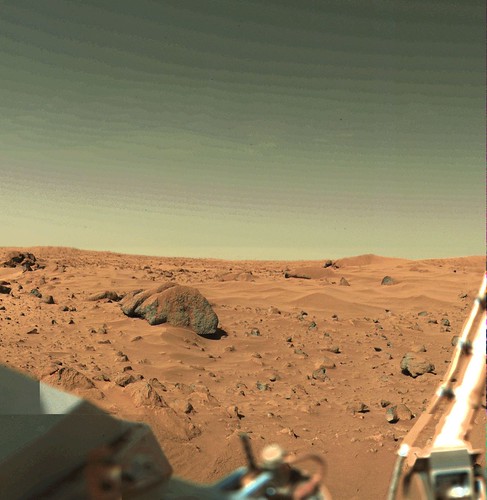
vikinglander1-11111 by dfrank39, on Flickr
Last edited by Vincent (2012-09-26 11:56:52)
Argument expected.
I don't require agreement when presenting new ideas.
-Dana Johnson
Offline
Like button can go here
#135 2012-09-26 12:17:54
- Vincent
- Banned
- From: North Carolina USA
- Registered: 2008-04-13
- Posts: 623
Re: Official MSL / Curiosity Rover Thread | Aug 5, 2012 10:31 p.m. PT
Argument expected.
I don't require agreement when presenting new ideas.
-Dana Johnson
Offline
Like button can go here
#136 2012-09-27 08:51:38
- hjs
- InActive
- From: Europe, Germany, Bavaria, Muni
- Registered: 2004-01-14
- Posts: 15
Re: Official MSL / Curiosity Rover Thread | Aug 5, 2012 10:31 p.m. PT
Hi Vincent!
In the context to that Viking Lander Skyview it tells, that the colours were "naturalized" by taking black-white highresolution pictures and the colour-channels input to produce colours as they would be seen by human eyes.
How does this great afternoon shot from MSL Mastcam show more blue than green?
The sunny side shows somewhat clean white, result of saturation?
Thanks for the link
hjs
Offline
Like button can go here
#137 2012-09-27 09:45:41
- Vincent
- Banned
- From: North Carolina USA
- Registered: 2008-04-13
- Posts: 623
Re: Official MSL / Curiosity Rover Thread | Aug 5, 2012 10:31 p.m. PT
The sky is blue. Dust makes it green. This is a matter of degree. Saturation is likely cause of white.
Vincent
Argument expected.
I don't require agreement when presenting new ideas.
-Dana Johnson
Offline
Like button can go here
#138 2012-09-28 10:12:42
- Vincent
- Banned
- From: North Carolina USA
- Registered: 2008-04-13
- Posts: 623
Re: Official MSL / Curiosity Rover Thread | Aug 5, 2012 10:31 p.m. PT
Trying to get past surface images of Mt Sharp weather is like trying to find a needle in a hay stack. What makes things even worse is when you try to research Mars weather you find your own presentations.
The equatorial images from ESA, of fog and low clouds was a great find. Gale Crater is at about 4.7 degrees south latitude. The wind tail from the dark airborne material seems to go more north south in the global views. These features on Mars are commonly referred to as drips, as in sinus drips because of their presentations. This suggest out-gassing during specific times of year. Maybe some geologist with more patience than me can find this etiology.
Looks like this MOC image shows clouds up-top on Mt Sharp. The smooth appearance it seems in reality is water ice clouds. Thermal profiles and reports by NASA of water ice haze at low levels and IR (infrared) daytime data with a negative lapse rate support this versus CO2.
This MOC image is all that is available that suggest clouds up-top. *High level water ice clouds seem to be present also because features outside in surroundings areas are blurred. The daytime IR shows the true texture, and curious thermal signatures significant only to the reports of olivine in thermal anomalies. This suggest atmospheric dust is the source of olivine.
To-date no Curiously image supports clouds up-top.
Fist image is a visible MOC. This shows a restriction of visibility. (Clouds up-top)

MOC Visible by dfrank39, on Flickr
Second image is daytime MOC IR. This is an unrestricted image. This shows true texture and the way it "should" look with no clouds.

GaleCraterMars_themis900 by dfrank39, on Flickr
Image Ref: http://www.msss.com/moc_gallery/r10_r15 … 00953.html
*High water ice cloud Ref: http://www.msss.com/msss_images/latest_weather.html
Daytime IR Ref: http://www.sddt.com/PhotoLibrary/?i=4385&pod=astronomy
Vincent
Last edited by Vincent (2012-09-28 10:31:04)
Argument expected.
I don't require agreement when presenting new ideas.
-Dana Johnson
Offline
Like button can go here
#139 2012-09-28 10:47:06
- Vincent
- Banned
- From: North Carolina USA
- Registered: 2008-04-13
- Posts: 623
Re: Official MSL / Curiosity Rover Thread | Aug 5, 2012 10:31 p.m. PT
Glenelg may be an old lake bed. Satellite date shows mud polygons.
Vincent
Argument expected.
I don't require agreement when presenting new ideas.
-Dana Johnson
Offline
Like button can go here
#140 2012-09-28 11:07:37
- GW Johnson
- Member
- From: McGregor, Texas USA
- Registered: 2011-12-04
- Posts: 6,036
- Website
Re: Official MSL / Curiosity Rover Thread | Aug 5, 2012 10:31 p.m. PT
Wouldn't surprise me a bit to see mud polygons from an old lake bed. The public news media are full of the story about the fossil gravel bar in the steam bed.
There once was a time when Mars had a very much thicker atmosphere and warmer environment. Streams and bodies of water, all nice and "stable", just like here. The northern lowlands look an awful lot like an old ocean bottom, too.
I would think that old stream beds and lake beds would be very good places to look with a real microscope for fossil remnants of microbial life. Those odd traces in the Allan Hills meteorite might be a pretty good guide to the size and form of the things we would be looking for. Too bad Curiosity isn't equipped for that.
GW
GW Johnson
McGregor, Texas
"There is nothing as expensive as a dead crew, especially one dead from a bad management decision"
Offline
Like button can go here
#141 2012-09-28 12:23:55
- Vincent
- Banned
- From: North Carolina USA
- Registered: 2008-04-13
- Posts: 623
Offline
Like button can go here
#142 2012-09-28 12:49:56
- Vincent
- Banned
- From: North Carolina USA
- Registered: 2008-04-13
- Posts: 623
Re: Official MSL / Curiosity Rover Thread | Aug 5, 2012 10:31 p.m. PT
Sorry that was a front view. This is a side view,
There was more than one.
Vincent
Image Ref: http://marsrover.nasa.gov/gallery/all/2 … 8L7M1.HTML

2P207413625EFFAS00P2278L7M1 by dfrank39, on Flickr
Last edited by Vincent (2012-09-28 13:10:22)
Argument expected.
I don't require agreement when presenting new ideas.
-Dana Johnson
Offline
Like button can go here
#143 2012-09-28 21:29:57
#144 2012-09-29 07:06:50
- louis
- Member
- From: UK
- Registered: 2008-03-24
- Posts: 7,208
Re: Official MSL / Curiosity Rover Thread | Aug 5, 2012 10:31 p.m. PT
Wouldn't surprise me a bit to see mud polygons from an old lake bed. The public news media are full of the story about the fossil gravel bar in the steam bed.
There once was a time when Mars had a very much thicker atmosphere and warmer environment. Streams and bodies of water, all nice and "stable", just like here. The northern lowlands look an awful lot like an old ocean bottom, too.
I would think that old stream beds and lake beds would be very good places to look with a real microscope for fossil remnants of microbial life. Those odd traces in the Allan Hills meteorite might be a pretty good guide to the size and form of the things we would be looking for. Too bad Curiosity isn't equipped for that.
GW
I think they have played down the possibility of finding fossils. But surely if this is a lake bed then if there was life on Mars we could expect to find some fossil life.
Let's Go to Mars...Google on: Fast Track to Mars blogspot.com
Offline
Like button can go here
#145 2012-09-29 10:22:35
Offline
Like button can go here
#146 2012-09-29 10:58:42
- GW Johnson
- Member
- From: McGregor, Texas USA
- Registered: 2011-12-04
- Posts: 6,036
- Website
Re: Official MSL / Curiosity Rover Thread | Aug 5, 2012 10:31 p.m. PT
The geologists tell us that the fossil record here on Earth is a very skewed sampling, and for a wide variety of reasons. Yet, what it seems to show is that life here was one-cell microbial for about 3 billion years, and may have begun almost as soon as liquid oceans formed, very shortly after the planet cooled enough to have a solid crust at all. How all of that life evolution interacts with changing climate and chemistry, and a slowly-dimming sun, is not well understood. But there it is.
This microbial sort of thing left only microscopic fossils, of similar size and form to the odd traces found in the Allan Hills meteorite, which rock came from Mars. Only in the last 660 million years or so does there seem to be evidence of multicellular life here. This is not conclusive, of course, but it does suggest that microbial life sprouts up quickly and easily in a liquid water environment, while multi-cellular forms may require a time constant on the order of 3 billion years, of benign conditions, to evolve. I could be wrong about that, but that's what the record here seems to say.
We have no reason to believe that the fossil record on Mars would not be as skewed as that on Earth, and probably for the all same reasons. There, like here, the geological record will be hard to interpret, especially any fossil record. What does seem very clear is that early Mars was much warmer and wetter, with similar conditions and chemistry to the earlier Earth. I'd bet real money it had microbial life, just like here. Maybe even the very same sort of life, if the panspermia hypothesis was a factor: the late heavy bombardment event could have spread microbes, or perhaps just their chemistry, between the two planets.
The problem is, from what we can tell, is that Mars too-quickly dried out (acidifying along the way), and froze up, as it lost its atmosphere. (For whatever reasons.) Apparently this was a couple of billion years ago. There might have been short warmer, wetter events since then, but that is not clear. My hypothesized 3-billion-year time constant for evolving multicellular forms didn't happen on Mars, as best we know. Accordingly, I would not bet real money on our finding macroscopic fossils. But, then, it's only a bet. No one yet knows.
I view putative macro fossils with a jaundiced eye, meaning I have a strong "show-me" attitude about that. There are so many ways for inanimate geology to create forms that look like life fossils, as we know. Putative microfossils on Mars I find much easier to accept, since the climate seems to have been hospitable to Earth-like life for a billion or two years, perhaps. I do think the NASA scientists who claimed microfossils in the Allan Hills meteorite were very badly mistreated by the scientific establishment. That would be one of Carl Sagan's few mistakes, reacting the way he did.
Here is what I predict: we may find microfossils of microbial life in sites scattered all over Mars. If we drill deep enough, we may, (I repeat "may") even find living microbes far under the surface, similar to deep-rock microbes found here recently. If we ever terraform Mars, that life may re-invade the surface and re-colonize it. I rather doubt Martian microbes could sicken us, or that our microbes present a threat to Martian microbes. The chemistry should be different enough after 2-3 billion years' isolation, to prevent any such compatibility, even if they had the same original panspermia source just after planetary formation.
All of that is just my speculation, of course. Enjoy.
GW
GW Johnson
McGregor, Texas
"There is nothing as expensive as a dead crew, especially one dead from a bad management decision"
Offline
Like button can go here
#147 2012-09-29 17:02:01
Re: Official MSL / Curiosity Rover Thread | Aug 5, 2012 10:31 p.m. PT
Just wanted to put my opinion in...
1 I dearly want to say that the fossils in the Allan hills meteorite where actually smaller then bacteria, the size of nanobes actually- http://serc.carleton.edu/microbelife/to … index.html
2 I want to say I speculate as well if there was multicellular organisms on mars, I think that they may have come from earth if there are any. Such as tardigrades.
3 I want to say that PEOPLE SHOULD STOP DISCRIMINATING AGAINST LIFE POSSIBLY ON MARS. It is very possible, and scientists can create bacteria that can live in a variety of mars climates, like lava caves, or on the surface. It seems to me that when you talk about life on other planets they think about how common things would be able to live there, and they think it must be impossible without even scratching the surface of the science. I believe strongly that there is life on mars and that it is similar to life on Earth.
-Koeng
Last edited by Koeng (2012-09-29 17:02:37)
Lets terraform today!
[url=http://www.terraformingforum.com]www.terraformingforum.com[/url]
Offline
Like button can go here
#148 2012-09-29 22:10:51
- SpaceNut
- Administrator
- From: New Hampshire
- Registered: 2004-07-22
- Posts: 29,599
Re: Official MSL / Curiosity Rover Thread | Aug 5, 2012 10:31 p.m. PT
Here is a post from an old time friend these words that follow are his:
Curiosity has returned images of an old stream bed. ![]()
The scientists say the conglomerates and rounded pebbles are definitely not the result of aeolian erosion and can only be the result of a substantial stream of water rolling the stones along over an extended period of time.
The discovery comes from examining two outcrops, called “Hottah” and “Link,” with the telephoto capability of Curiosity’s mast camera during the first 40 days after landing.
... The rounded shape of some stones in the conglomerate indicates long-distance transport from above the rim [of the crater], where a channel named Peace Vallis feeds into the alluvial fan. The abundance of channels in the fan between the rim and conglomerate suggests flows continued or repeated over a long time, not just once or for a few years.
By the way, here's where the rover is now - about halfway between where it landed and 'Glenelg', which is where they want to do some drilling etc.
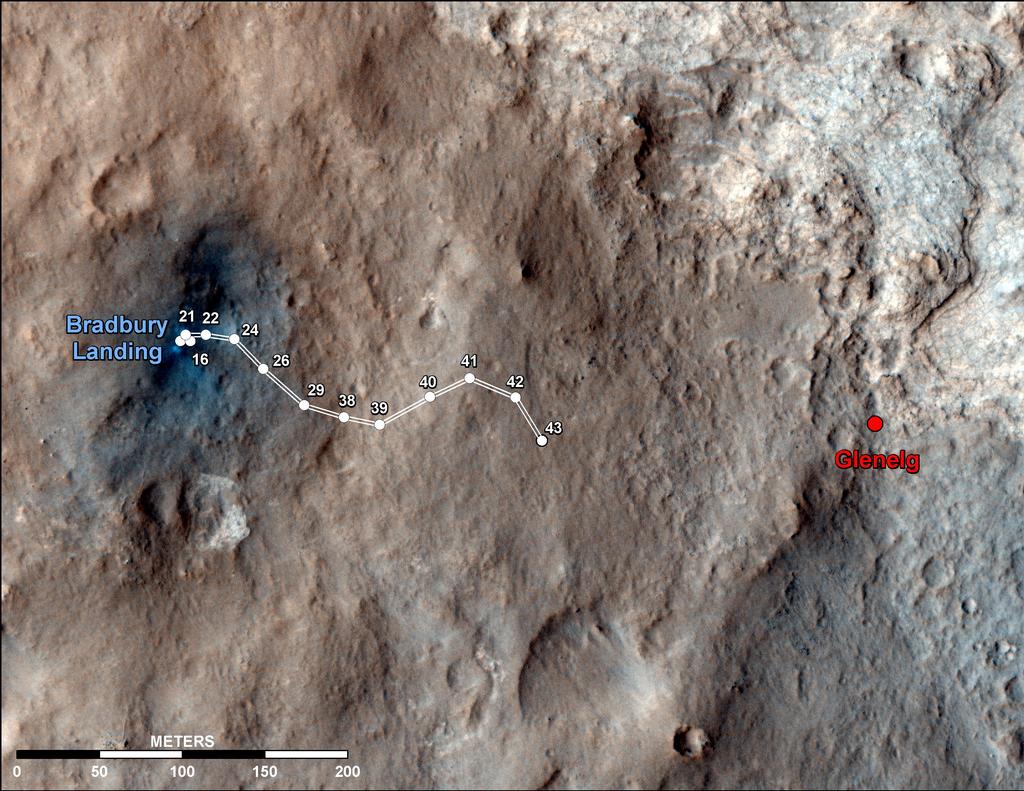
A great comparative geology picture of old stream beds on Mars and Earth shows the remarkable similarity between water-affected rocks on the two planets:

This set of images compares the Link outcrop of rocks on Mars (left) with similar rocks seen on Earth (right).
The image of Link, obtained by NASA’s Curiosity rover, shows rounded gravel fragments, or clasts, up to a couple inches (few centimeters), within the rock outcrop. Erosion of the outcrop results in gravel clasts that fall onto the ground, creating the gravel pile at left. The outcrop characteristics are consistent with a sedimentary conglomerate, or a rock that was formed by the deposition of water and is composed of many smaller rounded rocks cemented together.
A typical Earth example of sedimentary conglomerate formed of gravel fragments in a stream is shown on the right. An annotated version of the image highlights a piece of gravel that is about 0.4 inches (1 centimeter) across. It was selected as an example of coarse size and rounded shape.
Rounded grains (of any size) occur by abrasion in sediment transport, by wind or water, when the grains bounce against each other. Gravel fragments are too large to be transported by wind. At this size, scientists know the rounding occurred in water transport in a stream.
They mention that the stream must have been moderately deep and fast-flowing for it to have achieved this kind of erosion.
“From the size of gravels it carried, we can interpret the water was moving about 3 feet per second, with a depth somewhere between ankle and hip deep,” said Curiosity science co-investigator William Dietrich of the University of California, Berkeley.
Great stuff! ![]()
There's been speculation about the evidence for streams and rivers on Mars for decades but now we have in-situ close-up photos showing the indisputable proof. B)
They're going to use their instruments now to analyse the 'cement' holding the sedimentary conglomerates together. This will tell them about conditions in the water at the time the conglomerates formed.
I imagine they'll be able to tell if the water was fresh or salt, acidic or alkaline, etc. Maybe they'll even be able to take a guess at the prevailing temperature range during formation(?).
Apparently it's hard to tell how old anything is on Mars, including this stream bed. But there is this quote from Dr. Dietrich:
It's hard to say how long ago this water flowed -- an estimate would be "thousands to millions of years," Dietrich said.
The estimate of thousands of years fits in with other conversations we've had in the past about evidence for heavy snowfall and glacier formation on high mountains on Mars.
You may recall my speculative conclusion that Mars' atmospheric pressure must have been very much higher in the relatively recent past for precipitation to occur at such altitudes. (see 'The ice @ Elysium' thread, in Mars Science)
Accumulating facts as I go along, I suspect the Martian atmosphere may be far more changeable than anyone in the scientific community wants to admit. And I'm not just talking about a difference of a few millibars from one season to another; I'm talking about hundreds of millibars coming and going over periods of hundreds of millenia.
My hypothesis, for what it's worth, is that since Mars lost the stabilising mass of its large ocean, its wildly swinging axial tilt causes very large climatic changes over that kind of time interval - including the intermittent formation and collapse of a substantial atmosphere of maybe 500-800 millibars on datum.
This seems to me to be the only way to explain some of the paradoxes we see in Martian geology. (And probably that half-tonne meteorite, 'Block Island' too) :huh:
If I'm right (big if!), we're just unlucky that we've arrived at Mars in the middle of one of its worst climatic phases.
Maybe if we'd arrived 50,000 years ago, or 20,000 years in the future, we'd have found a completely different Mars - with cool clear water running over those rounded pebbles in that stream bed. ![]()
O.K. I've just taken my meds. Back to reality now! ![]()
Offline
Like button can go here
#149 2012-09-30 05:20:15
- Vincent
- Banned
- From: North Carolina USA
- Registered: 2008-04-13
- Posts: 623
Re: Official MSL / Curiosity Rover Thread | Aug 5, 2012 10:31 p.m. PT
New all-time record high temperature of 7C or 45F on sol 52. We just past the spring equinox so warmer days are ahead.
The previous post seem to express the current thinking in regard to life on Mars. Any current surface life is most likely microscopic. Any multi-cellular life is most likely subterranean.
Fossils are not my area of expertise. Some claim to have seen them. Sir Charles Shultz is most notable. Whether they are real or imagined is unclear. Earth eyes see Earthly things.
Vincent
Wx link: http://marsweather.com/data
Sir Charles: http://www.shultslaboratories.com/
Argument expected.
I don't require agreement when presenting new ideas.
-Dana Johnson
Offline
Like button can go here
#150 2012-09-30 13:04:42
- Vincent
- Banned
- From: North Carolina USA
- Registered: 2008-04-13
- Posts: 623
Offline
Like button can go here
